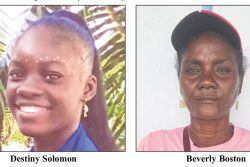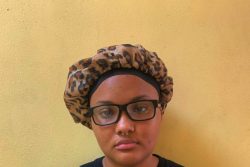Reviewed by Romona Bennett
![]() This week we present a book review. The novel Something Buried in the Yard by Michelle Asantewa is reviewed by Romona Bennett. This work is by a Guyanese author resident in the United Kingdom who has researched the Guyanese traditional religious ritual Kumfa (cumfa) and has based her novel on that ritual. Further, she has presented a fictionalised account of her own family background in Guyana. She does a similar thing with the biography of her mother, and has also written Mama Lou Tales stories that come out of that experience.
This week we present a book review. The novel Something Buried in the Yard by Michelle Asantewa is reviewed by Romona Bennett. This work is by a Guyanese author resident in the United Kingdom who has researched the Guyanese traditional religious ritual Kumfa (cumfa) and has based her novel on that ritual. Further, she has presented a fictionalised account of her own family background in Guyana. She does a similar thing with the biography of her mother, and has also written Mama Lou Tales stories that come out of that experience.
Romona Bennett is a lecturer at the University of Guyana in the Department of Language and Cultural Studies at the Faculty of Education and Humanities. Among her special interests is feminist literature. She has also undertaken research into Amerindian literature and has edited a collection of stories written in Arawak by Canon John P Bennett, distinguished lexicographer and authority on Amerindian languages (who happens to be her grandfather).
The fiction writer Michelle Asantewa has also published Guyanese Komfa: the ritual art of trance, a documentation of the Guyanese traditional form, representing work she did at the London Metropolitan University in London. Kumfa is widely known in Guyana as a folk religion, but at the same time is not very well known. People generally misunderstand it, approaching it with fear or ridicule, but largely because they are uninformed. On the one hand they laugh at it and use the term “ketch kumfa” to describe persons dancing to drums in a trance when possessed by the rhythms. At the same time they fear it and confuse it with obeah.
But kumfa is an African derived religious practice arising from ancestor worship. Devotees call upon the spirits of the ancestors – the deities or gods to assist them or in order to honour them. A “wuk”, a ritual ceremony or “feast” is held to give thanks, for some achievement, or to seek a cure in cases of illness, or to seek assistance in cases of problems. The drums are used to invite the spirits and to invoke possession by spirits, and it is through this dance and spirit possession that the deities intervene to mend human ills. (Al Creighton)
Michelle Asantewa’s Something Buried in the Yard is an absorbing novel which focuses on several generations of the Quamina family and which is set mainly in the fictional Sunrise Village, Guyana. But this is no family saga. In fact, in the ‘Author’s Note’ to the novel, there is a hint that we should not expect a central protagonist or a linear plot.
These are her intentions. Nor should we expect fully developed characters. Be prepared instead to experience a novel which reflects the characteristics and dynamics of Kumfa – an intermixing of several characters (including positive and negative ancestral spirits and spirit guides); the fusion of various storylines and perspectives; and the “trance states or altered states of consciousness” (Author’s Note, vii – viii). Significantly, it is Kumfa that acts as a pivot of the novel; and in particular, one ritual which takes place in the election year 1992.
The 1992 storyline opens three days after this Kumfa ritual with the perspective of Bess, a caulbearer, and one of five surviving siblings of third generation Quamina lineage. Through her shifting states of consciousness, especially her ability to “discourse” (8) with the ancestral spirits and elders, we learn that the ritual failed somewhat, that somebody “[mix] up the work,” and that “next work got to do!” So why was the Kumfa done in the first place?
As the novel shifts perspective from Bess to each of her four siblings, several important details emerge: a young child of the family has recently died under suspicious circumstances; this death would be the third such death in the history of the family and it may not be the last; that Bess’s eyes were steamed in her childhood to rid her of the powers of the caul; and that there are secrets buried in the family’s ancestral memory.
With the storylines weaving in and out of different states of consciousness (including the “omniscient spirit consciousness”), the reader becomes privy to the lives of the Quamina siblings – Bess’s ability to “double hear and double see” (22); “wotless” Joey’s instability; Themar’s relationship struggles and spiritual conflicts; Titty’s relative success in England and the painful loss of her child; and Euna’s unfulfilled dreams and continual yearning for England and the life she imagines her sister Titty enjoys. We also learn of another pending tragedy with Euna’s daughter Maya, who is often compared to her “flighty” Aunt Bess.
The structure of the novel keeps the reader engaged to find the “something buried”. What is it that has caused trauma in the Quamina family to transcend temporal and spatial boundaries? We are repeatedly reminded that something “deh in we blood” (9); according to one of the ancestral spirits, “too much mistake make in we life and now the children own. Is up to we to fix what we can fix now” (82). While the novel suggests that colonialism has contributed to these ruptures and fissures, it also implies that the descendants of the Quaminas must finally leave their “hearing and deaf, seeing and blind” (129) state. This process includes, but is not limited to, an acceptance of neglected beliefs and rituals.
We are warned very early in the novel that “blood spills like curdling milk if it is not reclaimed” (7). Interestingly, this reclaiming of the symbolic blood is as complex as the ritual of Kumfa. In the metaphoric space of the ritual, it involves a synchronised effort from all participants and a willingness to move beyond racial and ethnic biases. By the end of the novel, the reader recognises that Something Buried is as much about condescending attitudes towards our traditional beliefs and rituals, as it is about the loss of those beliefs and rituals. It is as much about Guyana and Guyanese (at home and in the Diaspora), as it is about the Quamina family.
Finally, it is as much about our history and memory, as it is about our contemporary lives. In the end, it is the reader who must discover for herself/himself that “something buried in the yard”.








